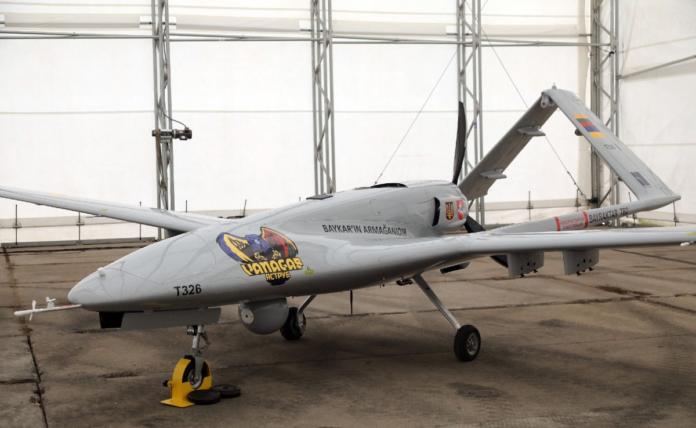Ukraine could receive Turkish-made drones able to launch cruise missiles, according to a new report, which would boost Kyiv’s ability to strike behind Russia’s defensive lines.
Whether or not Turkish manufacturer Baykar will donate any of its Bayraktar Akinci drones to Ukraine is “under consideration, as far as I know,” Haluk Bayraktar, its CEO, told Radio Free Europe/ Radio Liberty.
Ukraine has long made use of Turkish-made Bayraktar TB2 unmanned combat aerial vehicles (UCAVs) in its fight against Russian forces. The medium-altitude, long-endurance drone can operate both as a surveillance asset or an attack drone, according to its manufacturer.
They quickly became a success with the Ukrainian military from the earliest days of the war, although they disappeared from Ukraine’s skies as Russia beefed up its air defenses months into the war. “Once the Russian military got its act together, it was able to down many TB2s,” Samuel Bendett, an analyst with the U.S. think tank, the Center for Naval Analyses, told Insider in May.
A Turkish Bayraktar TB2 combat drone is on view in Siauliai, Lithuania, on July 6, 2022. Whether or not Turkish manufacturer Baykar will donate any of its Bayraktar Akinci drones to Ukraine is “under consideration, as far as I know,” said the company CEO. PETRAS MALUKAS/AFP via Getty Images
The Bayraktar TB2s are credited with destroying a confirmed five Russian tanks, eight armored fighting vehicles, 15 of Moscow’s surface-to-air missile systems and 10 helicopters since the outbreak of all-out war in late February 2022. According to Dutch open-source intelligence outlet, Oryx, Ukraine has lost a confirmed 24 TB2s, but the true figure is likely higher as this only includes visually verified losses.
In July, Baykar started construction on a manufacturing plant for its Bayraktar TB2s inside Ukrainian territory. The plant could be up and running within the next 18 months, Haluk Bayraktar added on the sidelines of a conference in Kyiv in late September.
“The Ukrainian military is well aware of what we manufacture,” Bayraktar added. “So our plan is to manufacture all the systems we have here.”
The Akinci is “a big step up from Bayraktar’s now-famous TB2 drone,” according to U.K.-based drone expert, Steve Wright. The Akinci is “massively larger” than the TB2, he told Newsweek.
The Akinci is “longer and wider than Bayraktar TB2,” with its wingspan reaching about 65 feet, according to Baykar. It can carry “various payloads” of up to 1,500 kilograms, or roughly 3,300 pounds, the manufacturer said in the description of its advanced drone, adding it is “capable of conducting operations that are performed with fighter jets.” This means can be used in air-to-ground and air-to-air attack missions.
Ukraine has been fighting its grueling war, now in its 20th month, without air superiority and a limited number of fighter jets in its air force. Although Ukrainian pilots are now training to fly U.S.-made F-16s, it is still not clear whether the fourth-generation jets will arrive in Ukraine before the end of the year or in early 2024.
Without these jets, Ukraine has struggled to contest Russia’s control of the airspace. Kyiv has had a relatively limited number of Soviet-era aircraft that can launch long-range missiles such as the Storm Shadow and SCALP cruise missiles provided by the United Kingdom and France.
Bayrak said the Akinci drone is compatible with a host of missiles, including the Gökdoğan air-to-air missile touted as being beyond visual range, the Bozdoğan infrared homing missile and the SOM stand-off cruise missile. The SOM missile has a range broadly similar to the 155 miles typically given as the range for the Storm Shadow and SCALP missiles.
“Aerial bombardment will also be possible with Akinci, which will reduce the load on fighter jets,” Bayrak added.
Cruise missiles like Storm Shadow often weigh in at nearly 2,900 pounds, and the Akinci “is just about able to lift that—quite a feat of drone engineering,” Wright said.
“However, the next challenge would be adding all the systems needed to reliably carry and release the missile,” which would likely take years in normal circumstances, Wright argued. “However, the speed with which the Ukrainians bolted the Storm Shadow to their Su-24 attack aircraft amazes me, and I imagine they could do the same trick with the Akinci,” he added.
The UAV will be able to fly at around 40,000 feet, staying airborne for up to 24 hours, according to the drone’s specification. The TB2 flies at around 18,000 feet, with a maximum altitude of 25,000 feet, and a much smaller payload capacity of 150 kg, or roughly 330 pounds.
Ukraine Eyes Cruise Missile Upgrade on Turkey’s Bayraktar Drones
Recent Comments
on Army vs. Coastal Carolina live stream, how to watch online, CBS Sports Network channel finder, odds
on AL Rookie of the Year Julio Rodriguez Spreads Joy and Sportsmanship to the Youth of Loma de Cabrera
on After UFC Fallout, Conor McGregor Offers a Valuable Piece of Advice to Free Agent Francis Ngannou
on Dubai International Airport sees 41.6 million passengers in first half of year, more than in 2019
on Devout athletes find strength in their faith. But practicing it and elite sports can pose hurdles
on Despite strong Lunar New Year holiday data, consumer spending in China isn’t roaring back just yet
on Dave Portnoy: Taylor Swift’s security should ‘drag Kim Kardashian to jail’ if she attends Eras Tour
on CONCEPT ART: New Details Revealed for Disney Cruise Line Lookout Cay at Lighthouse Point Destination
on “Completely Knocked Me Out”: Rob Lowe Recalls Boxing Match With Tom Cruise On 1983 Brat Pack Classic
on CBS Sports, Serie A announce new TV rights deal; Paramount+ to air over 400 Italian soccer matches
on Cam Newton’s Violent Public Incident Draws Hilarious Reaction From 3x All-Star: “Where Do I Sign Up
on Boston College vs. Army live stream, how to watch online, CBS Sports Network channel finder, odds
on Angel Reese Launches Foundation Dedicated To Empowering Women Through Sports & Financial Literacy
on A weaker dollar, skyrocketing prices and ‘record’ visitor numbers: Good luck in Europe this summer




